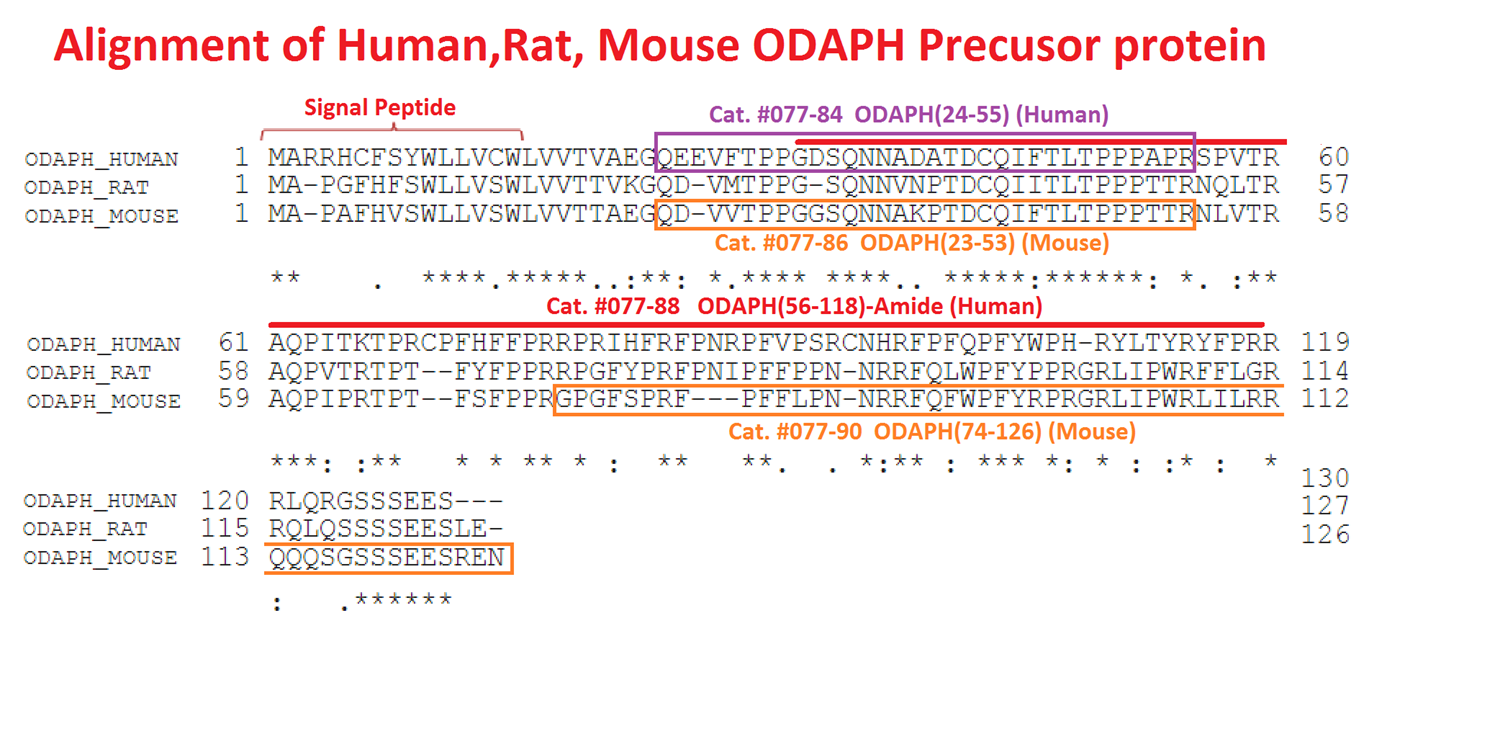Catalog # |
Size |
Price |
|
|---|---|---|---|
| 077-84 | 100 µg | $260 |
 )
)
|
pGlu-Glu-Glu-Val-Phe-Thr-Pro-Pro-Gly-Asp-Ser-Gln-Asn-Asn-Ala-Asp-Ala-Thr-Asp-Cys-Gln-Ile-Phe-Thr-Leu-Thr-Pro-Pro-Pro-Ala-Pro-Arg
|
| 3441.4 | |
|
| ≥ 95% |
|
| Exhibits correct molecular weight |
|
| Soluble in water |
|
|
Up to 6 months in lyophilized form at 0-5ºC. For best results, rehydrate just before use. Aliquot before freezing to avoid repeated freeze-thaw cycles. |
|
| White powder |
|
| Each vial contains 100 μg of NET peptide. |

Background: Mutation in Odontogenesis-associated phosphoprotein (ODAPH) has been reported to cause recessive hypomineralized amelogenesis imperfecta (AI) in human. However, the exact role of ODAPH in amelogenesis is still unknown.
Results: ODAPH was identified as a novel constituent of the atypical basal lamina located at the interface between maturation ameloblasts and the enamel by dual immunofluorescence staining of ODAPH and LAMC2. Odaph knockout mice were generated to explore the function of ODAPH in amelogenesis. Odaph-/- mice teeth showed severely attrition and reduced enamel mineralization. Histological analysis showed from transition or early-maturation stage, ameloblasts were rapidly shortened, lost cell polarity, and exhibited cell pathology. Abundant enamel matrix marked by amelogenin was retained. Temporary cyst-like structures were formed between flattened epithelial cells and the enamel from maturation stage to eruption. The integrity of the atypical basal lamina was impaired indicated by the reduced diffuse expression of LAMC2 and AMTN. The expression of maturation stage related genes of Amtn, Klk4, Integrinβ6 and Slc24a4 were significantly decreased.
Conclusions: Our results suggested Odaph played vital roles during amelogenesis by maintaining the integrity of the atypical basal lamina in maturation stage, which may contribute to a better understanding of the pathophysiology of human AI. This article is protected by copyright.
Ji Y, Li C, Tian Y, et al. Maturation stage enamel defects in Odontogenesis?associated phosphoprotein (odaph) deficient mice. Developmental Dynamics. Published online March 31, 2021:dvdy.336.
Abstract: Mutations of Odontogenesis-Associated Phosphoprotein (ODAPH, OMIM *614829) cause autosomal recessive amelogenesis imperfecta, however, the function of ODAPH during amelogenesis is unknown. Here we characterized normal Odaph expression by in situ hybridization, generated Odaph truncation mice using CRISPR/Cas9 to replace the TGC codon encoding Cys41 into a TGA translation termination codon, and characterized and compared molar and incisor tooth formation in Odaph+/+, Odaph+/C41*, and OdaphC41*/C41* mice. We also searched genomes to determine when Odaph first appeared phylogenetically. We determined that tooth development in Odaph+/+ and Odaph+/C41* mice was indistinguishable in all respects, so the condition in mice is inherited in a recessive pattern, as it is in humans. Odaph is specifically expressed by ameloblasts starting with the onset of post-secretory transition and continues until mid-maturation. Based upon histological and ultrastructural analyses, we determined that the secretory stage of amelogenesis is not affected in OdaphC41*/C41* mice. The enamel layer achieves a normal shape and contour, normal thickness, and normal rod decussation. The fundamental problem in OdaphC41*/C41* mice starts during post-secretory transition, which fails to generate maturation stage ameloblasts. At the onset of what should be enamel maturation, a cyst forms that separates flattened ameloblasts from the enamel surface. The maturation stage fails completely.
Liang T, Hu Y, Kawasaki K, et al. Odontogenesis-associated phosphoprotein truncation blocks ameloblast transition into maturation in OdaphC41*/C41* mice. Sci Rep. 2021;11(1):1132.
Abstract: Autozygosity mapping and clonal sequencing of an Omani family identified mutations in the uncharacterized gene, C4orf26, as a cause of recessive hypomineralized amelogenesis imperfecta (AI), a disease in which the formation of tooth enamel fails. Screening of a panel of 57 autosomal-recessive AI-affected families identified eight further families with loss-of-function mutations in C4orf26. C4orf26 encodes a putative extracellular matrix acidic phosphoprotein expressed in the enamel organ. A mineral nucleation assay showed that the protein's phosphorylated C terminus has the capacity to promote nucleation of hydroxyapatite, suggesting a possible function in enamel mineralization during amelogenesis.
Parry DA, Brookes SJ, Logan CV, et al. Mutations in c4orf26, encoding a peptide with in vitro hydroxyapatite crystal nucleation and growth activity, cause amelogenesis imperfecta. The American Journal of Human Genetics. 2012;91(3):565-571.
No References
| Catalog# | Product | Size | Price | Buy Now |
|---|
Social Network Confirmation